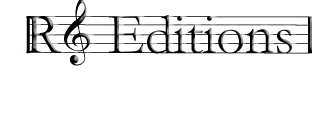I started RG Editions way back in 1996 .. (why do I have such a small catalogue!), as a "sideline" activity to my main job of playing concerts, primarily with London Baroque. Part of the business of performing baroque music involves the constant search for new repertoire - and the need to make performing editions of the pieces discovered. Having spent quite so much time setting and editing a vast amount of music, it seemed only sensible to make at least some of it generally available - and I also thought (laughably in hindsight) to recoup some of the library, equipment and time costs!!
The first edition was the six sonatas for two violins, by the little known Swiss composer, Gaspard Fritz. We were specifically asked to perform one of these duos in a concert, playing from a facsimile copy sent by the promoter. With surprise and joy we learnt the piece (the fourth, in d minor), and I realised we had stumbled upon a veritable treasure. What lovely, idiomatically written, charming music. Immediately, I asked the promoter (who will of course remain nameless!) for copies of all six - and sadly was refused. Luckily the duos were publlshed, twice in fact, in the 18th century, so I was able to secure copies from libraries; - and so it began.
( ... for those interested in the technical side of things, follow this
link ... )
Since then I have continued to perform with London Baroque, and now in addition have the post of Professor of Baroque Violin at the Hochschule für Musik in Cologne. Which all means that my interest in making good editions available increases all the time - matched only by the seemingly ever smaller amount of time in which to do it. These days many people have computer software to make editions (Sibelius, Finale etc), but what too few seem to realise is that it is a double-edged sword. Yes, very quickly you can produce something that looks surprisingly professional. But there are two enormous issues. First, it takes a lot of fiddling around (= many hours) to make a sensible layout - avoiding, for example, that last bar stretching across a whole line, or making usable page-turns. Secondly, and more importantly, is the fact that a neat looking printed page carries a certain degree of authority - most players look at the page and assume that what they see is what they should play - notes, dynamics, articulation, tempo etc. That means that you, as an editor/publisher carry a big responsibility - first to get the notes right (hours of proof-reading!!), and secondly to be very clear and careful about any changes you make from your source - any "editorial interference", as I call it.
I am in the business of "authentic" or period instrument performance practice (or HIP, as it is called these days - Historically Informed/Inspired Performance). Which means that I think an edition should communicate as clearly as possible everything that history has seen fit to pass down to us about the composer's intentions. Adding articulations, dynamics, slurs and other performing instructions gets in the way .. on the other hand, releasing a modern edition which is no more than a transcription of an inaccurate or questionable source is also difficult for a perfomer to deal with. You want to be able to put the music on the stand, and get on with the music making. So my aim with RG Editions is to satisfy both conditions - historically responsible, and practically useful.
And also, of course, to publish music that is worth playing!!
I hope that I'm succeeding -- if you have any comments or suggestions, please don't hesitate to contact me at: rgeditions@gmail.com
